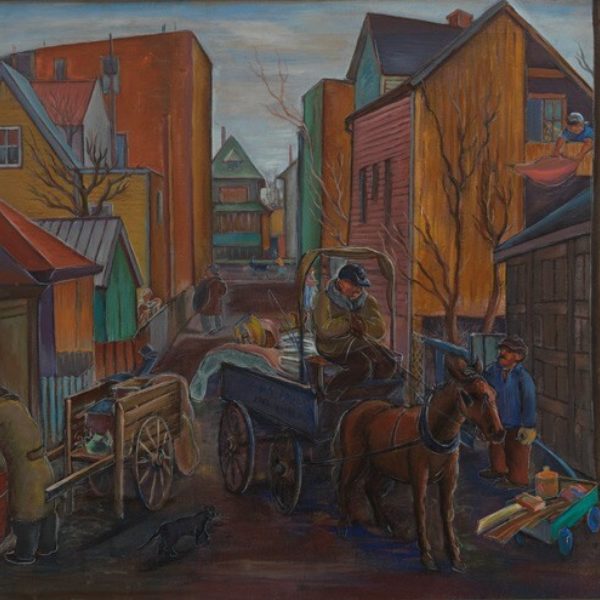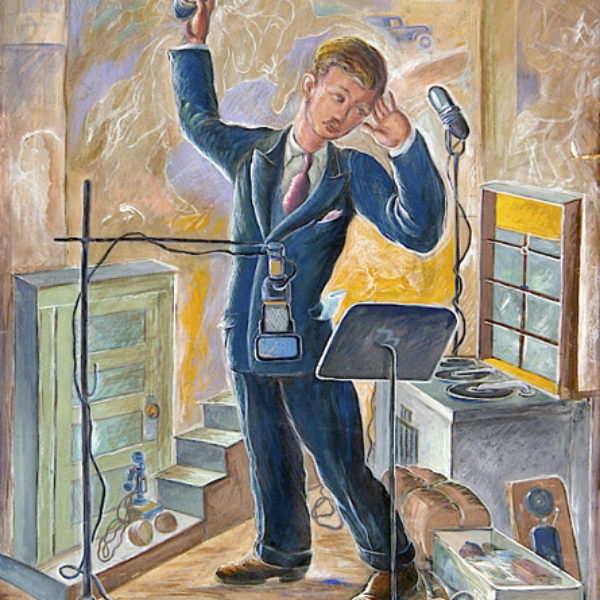A. Raymond Katz
b. 1895, Kassa, Hungary - d. 1974, New York, NY
A. Raymond Katz was born in 1895 in Kassa, a military town in northern Hungary. His father was a tailor who made military uniforms. After the young artist started selling his work in Kassa, his father permitted him to study art in New York. He came to the United States in 1909 at age 14 (his given first name, Sandor, was anglicized to Alexander) and supported himself in New York with a variety of odd jobs. Katz eventually found employment in a lithography shop in Chicago producing war posters, earning enough money to build a house and bring his family to the United States.
After the war, Katz traveled to the West Coast and Canada, arriving back in Chicago rich in experience and in need of a paying occupation. He took a job at the Barron Collier company designing car card advertisements, but quit in 1922 to enroll at the School of the Art Institute of Chicago (SAIC) and the Chicago Academy of Fine Arts. He supported himself with jobs in the burgeoning motion picture field, ultimately as the director of the art department of the Balaban and Katz (no relation) theater empire, where he oversaw the decoration of the movie palaces of the 1920s. In 1927, Katz and his family (he married in 1924) traveled back to Kassa where he pursued his first love, fine art. He reconnected with his Jewish heritage and brought back to Chicago many images of Jewish life. Although he continued to do commercial work throughout his career, he increasingly began to explore Jewish themes and was the recipient of numerous commissions for synagogues all over the country, creating stained glass windows, murals, reliefs, sculptures, and decorative items for them. He set up a studio in his apartment building and opened an office in the tower of the Auditorium Building that also housed the Little Gallery, an important venue for progressive art in the city, which he operated until 1933.
Katz also explored the aesthetic and philosophical interpretations of Hebrew letters, as seen in the woodcut Moses and the Burning Bush, which he submitted to the portfolio, A Gift to Birobidjan in 1937. Hebrew letters are integrated into the image: the first initial of Moses’s name crowns his head; the first letter of the name of God appears inside the flame; and his staff is topped by a letter.
During the Depression, the architect Frank Lloyd Wright urged Katz to become a muralist and in 1933, he was one of eleven artists chosen to create murals for the 1933 Century of Progress Exposition in Chicago, where his enormous secular work, O.K., was installed in pavilion three of the General Exhibits Building along with a series of murals addressing Jewish themes in the Hall of Religions. He won the competition for best poster for the fair in 1934. In 1936, he was commissioned to paint murals representing the Ten Commandments, for the Loop Synagogue in Chicago, then thought to be the first murals in an Orthodox synagogue.
In addition to his work for Balaban and Katz, he served as director of the poster department at Paramount Studios (1926–31), and the director of posters for the Chicago Civic Opera (1930–33), developing his graphic talents as well as his fine arts skills. His large gouache on paper, Untitled (Radio performer), reflects his background in theater, offering a behind-the-scenes view of the radio business. It is an animated portrait of a sound technician in front of a microphone, shooting a gun (presumably with blanks) and surrounded by paraphernalia of the sound effects trade. Evidence of the close relationship between his commercial work and his pursuits as a painter are found in an illustration from The Chicagoan (July 1933), a short-lived periodical that employed Katz frequently as a graphic artist. His drawing shows a family in front of their radio from which emerges a fantastic variety of entertainments in an overall pattern stylistically similar to that of Untitled (Radio Performer).
Like many artists in the 1930s, Katz participated in the government-supported arts projects. In 1936, Katz won the commission to paint the mural, History of the Immigrant, for the post office in Madison, Illinois, from the Treasury Department, the most prestigious of the projects. His style and subject matter, like that of many of his contemporaries, reflected the mandate to represent “the American Scene.”
His oil painting, Chicago Street Scene, 1936–42, is one of a series of images of Chicago’s alleys that Katz produced during the Depression. Highlighting the small-town camaraderie that was fast disappearing in 1930s America, Katz also alludes to the poverty of the period in the peddlers making their way on foot with wheelbarrows and horse-drawn carts. The color scheme, brilliant and jarring in this representation of material austerity that extends to the leafless trees, lends a bit of optimism to the dark times. The idea that art could change the world was one that Katz subscribed to in images such as this one.
Katz moved to New York in the 1950s, and died in 1974.
Susan Weininger and Lisa Meyerowitz
References
Bulliet, C. J. “Artists of Chicago Past and Present: No. 14: A. Raymond Katz.” Chicago Daily News, May 25, 1935.
Harris, Neil. The Chicagoan: A Lost Magazine of the Jazz Age. Chicago: University of Chicago Press, 2008.
Oakton Community College. A Gift to Biro-Bidjan: Chicago, 1937: From Despair to New Hope. Exhibition website, www.oakton.edu/museum/Katz.html.
Weaver, William R. “Sandor to You.” The Chicagoan (June 1934), 29, 57–58.
Weininger, Susan. “A. Raymond Katz.” In Chicago Modern, 1893–1945: Pursuit of the New, edited by Elizabeth Kennedy, p. 126. Chicago: Terra Foundation of American Art, 2004.
Yochim, Louise Dunn. Role and Impact: The Chicago Society of Artists, p. 248. Chicago: Chicago Society of Artists, 1979.

